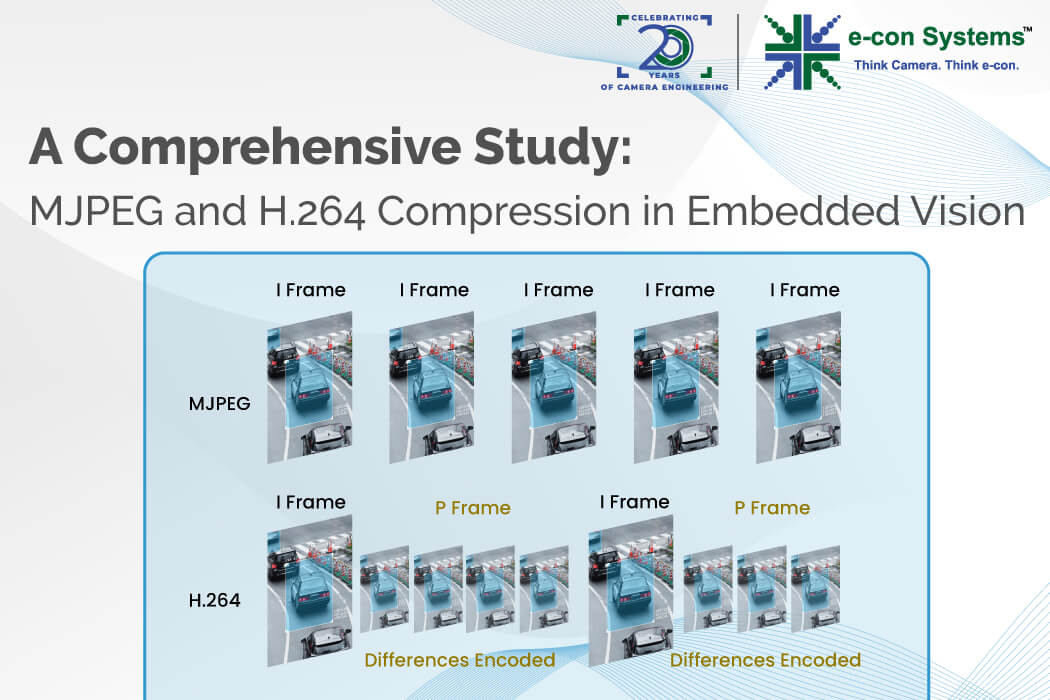MJPEG and H.264 are both video compression formats; however, they both utilize different methods to achieve compression. MJPEG compresses each video frame independently using JPEG compression, but H.264 uses more advanced techniques, like inter-frame compression, resulting in better compression efficiency and video quality.
As the demand for high-quality visual data processing grows, the choice of compression techniques becomes essential. Finding the right balance between bandwidth efficiency and image quality is crucial for ensuring optimal performance across diverse industries. Let’s explore in detail MJPEG and H.264 compression methods so that you can find the right compression method for your application.
Understanding MJPEG Compression
Motion JPEG (MJPEG) is a video compression format that concentrates on individual frames within a video sequence. Each frame is treated independently, resulting in a series of compressed images. This intra-frame compression method provides excellent image quality, making it suitable for applications whose clarity is of utmost importance.
MJPEGs are still prevalent because they can be quickly processed and edited. Besides, it uses a simple compression format, leading to lower latency in some applications.
Applications of MJPEG Compression
Some legacy systems use MJPEG compression as upgrading software or hardware to support new compression standards might not be cost-effective. MJPEG can be utilized in systems prioritizing real-time video processing and minimal delay. Here are some applications of MJPEG:
- Medical Imaging: MJPEG is essential in medical applications, like microscopy, in-vitro diagnostic (IVD) devices, fundus imaging, remote patient monitoring through medical imaging, and surgical cameras. It preserves the intricate structures in microscopic images with frame-by-frame encoding and ensures minimal loss of image fidelity during data compression.
- Surveillance Systems: MJPEG’s high-quality image maintenance makes it ideal for surveillance cameras, crucial in situations where each frame is pivotal for real-time security.
- Broadcasting Solutions: Leveraged in broadcasting for transmitting high-definition video, MJPEG excels in capturing minute details, meeting demanding quality standards.
Considerations for MJPEG
MJPEG compression, while versatile, requires careful considerations. Here are some considerations to take into account before choosing MJPEG compression methods:
- Storage Space
MJPEG tends to occupy more storage space compared to other compression methods due to its intra-frame nature. This makes it suitable for applications with sufficient storage capacity, striking a balance between detailed image preservation and storage efficiency.
- Low Latency Requirements
MJPEG is ideal for circumstances where low latency is crucial, such as live video streaming or real-time monitoring. Its frame-by-frame approach ensures quick data transmission, making it a preferred choice for applications demanding minimal delays in visual data processing.
- Bandwidth Utilization
Assess the bandwidth requirements, as MJPEG’s frame-by-frame encoding may impact data transmission speed and overall network utilization in applications with rigid bandwidth constraints. Consider optimizing network resources to ensure seamless performance in bandwidth-sensitive scenarios.
Understanding H.264 Compression – The Golden Standard
H.264, also known as Advanced Video Coding (AVC), is a widely utilized video compression standard. It adopts an inter-frame compression method, emphasizing the differences between frames to reduce repetition. This approach strikes a balance between video quality and file size, making H.264 efficient for various applications.
Codecs is a software used for video encoding, and H.264/H.265 codecs are utilized in embedded cameras. H.264 video encoder performs several steps to produce a compressed H.264 bitstream.
H.264 has a golden frame, which is 100% true images, and uses block-oriented compression to define the differences from Frame A to Frame B. Block-oriented compression helps to reduce the storage costs and permits streaming high-quality and detailed video without taking too much data, which MJPEG video will never be able to load fast enough.
Applications of H.264 Compression
H.264 compression stands as a keystone in various applications, excelling in delivering efficient video compression without sacrificing quality, like watching Netflix, Youtube, and surveillance video in HD quality. Here are some applications of H.264:
- Video Streaming: Widely adopted for its efficient compression, H.264 plays a pivotal role in seamless video streaming, ensuring high-quality content delivery over varied bandwidths.
- Video Conferencing: H.264’s ability to maintain a balance between video quality and file size makes it a go-to choice for video conferencing platforms, facilitating smooth real-time communication.
- Telemedicine: In telemedicine, where visual clarity is paramount, H.264 facilitates seamless transmission of medical imaging and live video, enhancing remote healthcare interactions.
- Remote Monitoring: H.264 supports effective remote monitoring by providing a balance between real-time visual data and bandwidth conservation, crucial in conditions like IoT deployments. It is the industry standard because ONVIF compliance requires H.264, and 90% of surveillance cameras utilize H.264.
Considerations for H.264</h4 >
When leveraging H.264 compression, certain factors merit careful consideration. Here are some key considerations to keep in mind while choosing H.264:
- Bandwidth Efficiency
H.264 is preferred in situations where bandwidth efficiency is critical, making it a popular choice for streaming services and real-time applications. Its inter-frame compression reduces redundancy, ensuring optimal data transmission without compromising video quality.
- Processing Power
While H.264 offers efficient compression, it may require more processing power due to inter-frame compression. This consideration is vital when selecting hardware for embedded systems, ensuring compatibility with the processing demands of H.264-encoded content.
- Latency Management
Assess the latency requirements of the application, as H.264’s inter-frame compression may introduce slight delays. This consideration is necessary in applications where real-time visual data processing is vital, such as live streaming or video conferencing.
A Comparison Between H. 264 And MJPEG
MJPEG is a slow series of slowly compressed pictures. Due to MJPEG files’ increased processing time and requirement of large storage space, they are only used on cameras. It takes around 5-20x the storage space than H.264, making long-term data retention expensive. Also, its processing time is 5-20x more than H.264, limiting it to the lowest-resolution cameras.
One notable advantage of MJPEG over H.264 and H.265 is that it can work in any legacy system, as it does not cause tearing or glitch effects in case of frame drop in low bandwidth situations.
However, with technological advancements, H.264 has become the industry standard due to its block-oriented compression technology, as it saves lots of space without losing valuable data. It utilizes the camera’s processing power, to a large extent, on the areas of the screen with activity, allowing for high-quality recording and much higher-resolution video when compared to MJPEG.
The hardware accelerated decoders are specialized hardware components incorporated in GPUs to offload and handle the decoding of compressed video data. Whether the video is compressed through MJPEG or H.246 compression methods, the hardware-accelerated decoders ensure video streams are efficiently decoded to improve the overall performance and responsiveness of the embedded system as they ensure seamless real-time processing.
Elevating Embedded Vision with e-con Systems
e-con Systems, an industry pioneer, has 20+ years of experience in designing, developing, and manufacturing OEM cameras for various industries, including medical and life sciences.
Check out the MJPEG solutions provided by us:
- RouteCAM_CU20 – Sony Starvis IMX462 Full HD GigE Camera
- RouteCAM_CU22_IP67 – Full HD Sony Starvis 2 IMX662 Lowlight GigE HDR Camera
Our H.264 solutions:
- Hyperyon® – 2MP Sony STARVIS IMX290 Ultra Low-light USB camera (Color)
- e-CAM83_USB – 4K Microsoft Teams compliant HDR USB H.264 Camera
- STURDeCAM81_CUOAGX – IP67 4K GMSL2 Camera for NVIDIA Jetson AGX Orin/AGX Xavier
- See3CAM_CU84 – 4K AR0830 USB 3.2 Gen 1 Camera (Color)
If you want to integrate H.264 or MJPEG into your product, write to our team at camerasolutions@e-consystems.com. You can even visit our embedded vision camera page or utilize our camera selector to explore the wide range of our vision solutions that fulfils your requirement.

Prabu is the Chief Technology Officer and Head of Camera Products at e-con Systems, and comes with a rich experience of more than 15 years in the embedded vision space. He brings to the table a deep knowledge in USB cameras, embedded vision cameras, vision algorithms and FPGAs. He has built 50+ camera solutions spanning various domains such as medical, industrial, agriculture, retail, biometrics, and more. He also comes with expertise in device driver development and BSP development. Currently, Prabu’s focus is to build smart camera solutions that power new age AI based applications.




